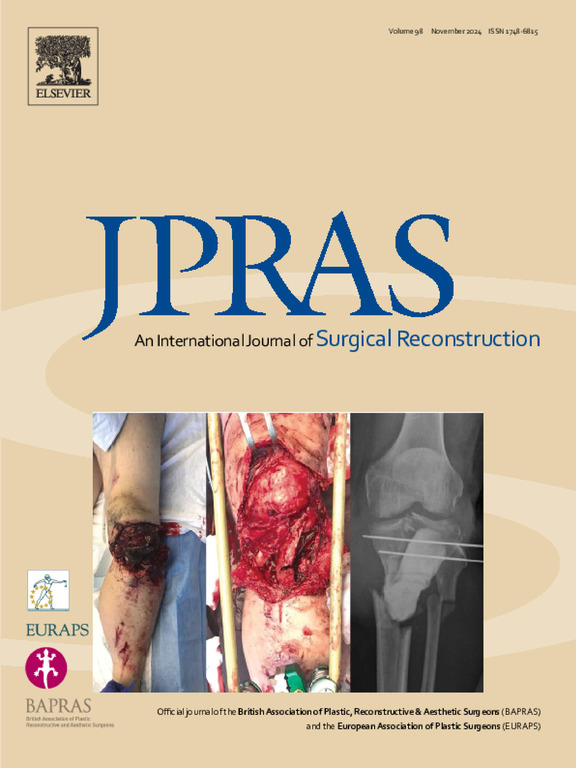妊娠相关性贝尔氏麻痹对生活质量和自我认知的影响:一项混合方法研究
IF 2
3区 医学
Q2 SURGERY
Journal of Plastic Reconstructive and Aesthetic Surgery
Pub Date : 2025-05-20
DOI:10.1016/j.bjps.2025.05.022
引用次数: 0
摘要
怀孕和贝尔氏麻痹都会对身体、心理和社会造成挑战。贝尔氏麻痹的发病率在妊娠晚期和产后上升,但很少有研究探索与妊娠相关的贝尔氏麻痹的生活经历。目的比较妊娠相关性贝尔麻痹与非妊娠相关性贝尔麻痹对生活质量和自我认知的影响。方法本调查研究采用收敛混合方法。17名参与者从悉尼面部神经诊所招募。收集的数据包括人口统计、临床信息、开放式回应和患者报告的结果测量。生活质量通过面部残疾指数和一份调查问卷来衡量,而自我感知则用凝视镜子的认知和影响评定量表来评估。使用Mann-Whitney U检验分析妊娠状态与结果测量之间的关系。其他预测因子是使用Fisher精确检验和回归模型确定的。对定性数据进行专题分析。结果年龄与外貌相关困扰呈负相关(β=−)。593, p= 0.025),年轻女性的痛苦更大。贝尔氏麻痹组和妊娠相关贝尔氏麻痹组在生活质量和自我知觉得分上没有统计学上的显著差异。专题分析确定了5个主要主题:医疗保健经历、身体形象、对日常生活的影响、改善医疗保健以及与妊娠相关的贝尔氏麻痹的影响。结论本研究突出了妊娠相关贝尔氏麻痹患者所面临的功能和社会心理挑战。有针对性的治疗指导,转诊途径和对妊娠相关贝尔麻痹的具体支持是必要的,以改善患者的预后。本文章由计算机程序翻译,如有差异,请以英文原文为准。
Impact of pregnancy-associated Bell’s palsy on quality of life and self-perception: A mixed methods study
Background
Pregnancy and Bell’s palsy both cause physical, psychological and social challenges. Incidence of Bell’s palsy rises in the third trimester of pregnancy and postpartum, yet few studies have explored the lived experiences of pregnancy-associated Bell’s palsy.
Aim
To assess the impact of pregnancy-associated Bell’s palsy on quality of life and self-perception compared to Bell’s palsy unrelated to pregnancy.
Methods
This survey study used a convergent mixed methods approach. Seventeen participants were recruited from the Sydney Facial Nerve Clinic. Data collected included demographics, clinical information, open-ended responses and patient-reported outcome measures. Quality of life was measured by the Facial Disability Index and a questionnaire, while self-perception was assessed with the Mirror Gazing Cognition and Affect Rating Scale. Associations between pregnancy status and the outcome measures were analysed using the Mann-Whitney U test. Other predictors were identified using the Fisher’s exact test and regression models. Thematic analysis was performed on qualitative data.
Results
Age was inversely associated with appearance-related distress (β=−.593, p=.025), with younger women having greater distress. No statistically significant differences in quality of life and self-perception scores were found between Bell’s palsy and pregnancy-associated Bell’s palsy groups. Thematic analysis identified 5 main themes: experience with healthcare, body image, impact on daily life, improving healthcare, and impact of pregnancy-associated Bell’s palsy.
Conclusion
This study highlights the functional and psychosocial challenges faced by pregnancy-associated Bell’s palsy patients. Targeted treatment guidance, referral pathways and specific support for pregnancy-associated Bell’s palsy are warranted to improve patient outcomes.
求助全文
通过发布文献求助,成功后即可免费获取论文全文。
去求助
来源期刊
CiteScore
3.10
自引率
11.10%
发文量
578
审稿时长
3.5 months
期刊介绍:
JPRAS An International Journal of Surgical Reconstruction is one of the world''s leading international journals, covering all the reconstructive and aesthetic aspects of plastic surgery.
The journal presents the latest surgical procedures with audit and outcome studies of new and established techniques in plastic surgery including: cleft lip and palate and other heads and neck surgery, hand surgery, lower limb trauma, burns, skin cancer, breast surgery and aesthetic surgery.

 求助内容:
求助内容: 应助结果提醒方式:
应助结果提醒方式:


